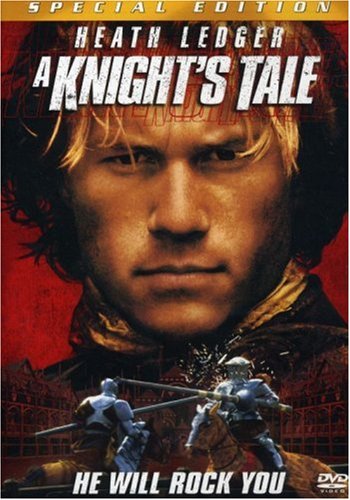All Nonfiction
- Bullying
- Books
- Academic
- Author Interviews
- Celebrity interviews
- College Articles
- College Essays
- Educator of the Year
- Heroes
- Interviews
- Memoir
- Personal Experience
- Sports
- Travel & Culture
All Opinions
- Bullying
- Current Events / Politics
- Discrimination
- Drugs / Alcohol / Smoking
- Entertainment / Celebrities
- Environment
- Love / Relationships
- Movies / Music / TV
- Pop Culture / Trends
- School / College
- Social Issues / Civics
- Spirituality / Religion
- Sports / Hobbies
All Hot Topics
- Bullying
- Community Service
- Environment
- Health
- Letters to the Editor
- Pride & Prejudice
- What Matters
- Back
Summer Guide
- Program Links
- Program Reviews
- Back
College Guide
- College Links
- College Reviews
- College Essays
- College Articles
- Back
A Knight's Tale
A Knight’s Tale, directed by Brian Helgeland, was released in 2001. Some of the top-billed actors are Heath Ledger, Rufus Sewell, and Paul Bettany. When released, the film made almost seventeen million dollars the opening weekend. The first time I watched the film was in Sophomore year Honors English class, after we had just read the Arthurian tale Le Mort D’Arthur.
The main character, William Thatcher, is a peasant squire for a knight named Sir Ector. When Sir Ector dies on the journey to a tournament, William creates a new identity and takes on the persona of a knight. He trains and competes in competitions, with the help of friends Roland, Wat, and Chaucer; which earns him more than he’s ever had during his poverty-stricken life. Through these tournaments he meets his lover, Jocelyn, and his nemesis, Count Adhemar. He enters the country’s highest level of competition, though not before experiencing many complications along the way.
A Knight’s Tale is based on The Canterbury Tales collection by Geoffrey Chaucer, who is also portrayed in the movie. The director’s depiction of Chaucer was not extremely accurate because Chaucer was known to be a cynical person who would not have been interested in this good and evil fight. There was also a knight name Sir Ulrich von Lichtenstein, who was portrayed as William’s alter ego. This is obviously wrong, because Lichtenstein existed as a real person rather than a borrowed name. The character of Edward, the Black Prince was also based on fact, but it was inaccurate because he did not receive ‘the Black Prince’ nickname until after he died. Lichtenstein and Edward competed against in each other, which would not have happened in reality because they lived in different centuries. The various tournaments depicted in the film are most accurate. A detail they failed to depict was the real purpose of the tournament; though it was meant to be fun and exciting for all, it was ultimately a practice for using their weapons at war. Though this film was inspired by many realities that existed in Medieval England, it is casually and intentionally anachronistic. Many of the costumes and sayings and melded from different centuries and eras, and the soundtrack was entirely from the late 20th century. Director Helgeland said that this anachronism was intentional. He reportedly wanted to have audiences realize the way that they felt about their music in the Middle Ages through the connection we have with our classics, like “We Will Rock You,” by Queen.
The film was set in Medieval England, but filmed mostly in Prague and the Czech Republic. Most of the settings, aside from intentional anachronisms, are depicted very realistically. The towns and villages feature gothic architecture that is characteristic of the 14th century. The class distinctions of the period were depicted accurately through clothing and actions of the characters; the rich, upper-class wore beautiful, bright-colored clothing and sat in nice arenas for social events, while the poor wore dirty rags and were confined to watch plays and tournaments from the ground. The weapons they used in tournaments, such as jousts and swords, were depicted well, along with the way men wore them and the tournaments themselves.
Overall, I really loved this film. It had very many strengths, and very few weaknesses. Heath Ledger succeeds as a heart-throb, who steals Jocelyn’s heart as well as my own. Paul Bettany is able to create a love/hate relationship with most viewers though his loud and at times belligerent portrayal of Chaucer. It contains successful narrative techniques: rising action, climax, falling action, happy ending; and emotional, universal themes: rags-to-riches, the importance of honor and bravery, and true love. It was very successful in holding my attention because of these crucial elements; the action of the tournaments, conflicts with his lover and rival, the heart-warming reunion of William and his father, and finally the underdog coming out on top. The incorporation of modern rock ‘n roll also played a huge roll because it brought out the meaning by connecting it with something viewers are familiar with and excited about. Though the film is somewhat historically accurate, it is ultimately a Hollywood movie. Many of the historical elements were either made to better the plot or completely unintentionally. Some of them were just completely false. The film doesn’t do much for history, but it can be enjoyed whether you know the real history or not. I would recommend this film to others, but not for its historical accuracy. This is a good movie, mainly because it was very well done and can be enjoyed by many people.
Similar Articles
JOIN THE DISCUSSION
This article has 0 comments.

